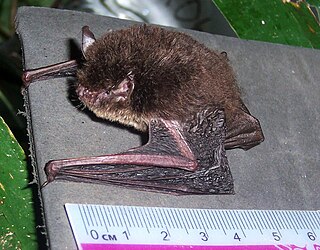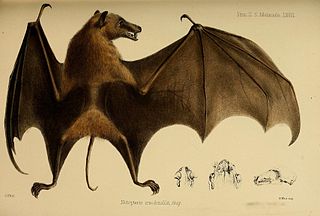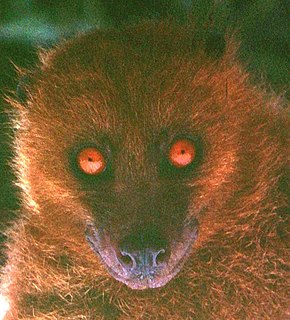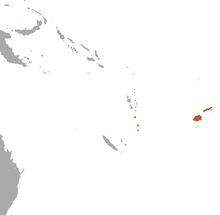
Kitti's hog-nosed bat, also known as the bumblebee bat, is a near-threatened species of bat and the only extant member of the family Craseonycteridae. It occurs in western Thailand and southeast Myanmar, where it occupies limestone caves along rivers.

The New Zealand long-tailed bat, also known as the long-tailed wattled bat or pekapeka-tou-roa (Māori), is one of 15 species of bats in the genus Chalinolobus variously known as "pied bats", "wattled bats" or "long-tailed bats". It is one of the two surviving bat species endemic to New Zealand, but is closely related to five other wattled or lobe-lipped bats in Australia and elsewhere. It was named the winner in the 2021 Bird of the Year competition in New Zealand, despite not being a bird.

The fringe-lipped bat is a leaf-nosed bat from southern Mexico to Bolivia and southern Brazil. It has three subspecies and no known fossils. It is the only species within its genus.

The wall-roosting mouse-eared bat, or Nepalese whiskered myotis is a species of vesper bat whose type locality is Nepal.

The Pacific sheath-tailed bat or Polynesian sheath-tailed bat is a species of sac-winged bat in the family Emballonuridae found in American Samoa, Fiji, Guam, Micronesia, Palau, Samoa, Tonga, and Vanuatu. Its natural habitat is caves.

Hildegarde's tomb bat is a species of sac-winged bat in the family Emballonuridae. It is found near the coast in Kenya and Tanzania where it feeds in tropical dry forests and roosts in caves. It is a diurnal species and the International Union for Conservation of Nature has assessed its conservation status as "endangered". The specific name hildegardeae was given in honour of anthropologist Hildegarde Beatrice Hinde.

The gray short-tailed bat, or Hahn's short-tailed bat, is a species of bat in the family Phyllostomidae native to Mexico and Central America.

The Fijian mastiff bat, also known as the Fijian free-tailed bat, is a species of bat in the family Molossidae. It is found in Fiji and Vanuatu. In 2013, Bat Conservation International listed this species as one of the 35 species of its worldwide priority list of conservation. This species is currently listed as endangered and considered a species of special concern due to habitat fragmentation and cave disturbance. The Fijian free-tailed bat is endemic to Fiji and Vanuatu islands. This species was previously documented on the islands of Taveuni and Vanua Levu, current research indicates possible small fragmented populations inhabiting both islands. Only two insectivorous bats occupy Fiji, the Pacific sheath-tailed bat and the Fijian free-tailed bat. Both species consume night flying insects, foraging high above the canopy.

The Mexican long-tongued bat is a species of bat in the family Phyllostomidae. It is the only species within the genus Choeronycteris. The species is found in El Salvador, Guatemala, Honduras, Mexico, and the United States.

The Khajuria's leaf-nosed bat, also known as Durga Das's leaf-nosed bat, is a species of bat in the family Hipposideridae. It is endemic to India. Its natural habitat is caves. It is threatened by habitat loss.

Notopteris is a genus of megabat in the family Pteropodidae. It contains the following species:

The Mediterranean horseshoe bat is a species of insectivorous bat in the family Rhinolophidae. It is found in the Mediterranean region and Balkan peninsula, as well as parts of Italy.

The Fijian monkey-faced bat Also known as Fijian flying fox or Fijian flying monkey, is a megabat endemic to Fiji. It was discovered in old-growth cloud forest on Des Vœux Peak, the second highest mountain peak on the island of Taveuni by William and Ruth Beckon in 1976, and is Fiji's only endemic mammal. It has recently been transferred from Pteralopex to its own monotypic genus Mirimiri.

The megabat tribe Macroglossini is within the subfamily Pteropodinae

The New Caledonia blossom bat is an uncommon species of megabat in the family Pteropodidae. The species lives in caves in northern New Caledonia, and forms colonies of up to 300.

The Madagascar free-tailed bat or Malagasy giant mastiff bat is a species of free-tailed bat formerly included as a subspecies of the large-eared free-tailed bat, but that was later considered to be a distinct, Malagasy species. The Madagascar free-tailed bat is endemic to northern, western, and southern Madagascar.
The East Asian free-tailed bat was formerly considered to belong to the same species as the European free-tailed bat. Its range includes China, Japan, and the Korean Peninsula.
Chaerephon atsinanana is a free-tailed bat found on Madagascar. It was considered a subspecies of the little free-tailed bat until 2010. During the day, they are known to roost in man-made structures such as the roofs or attics of buildings.


















